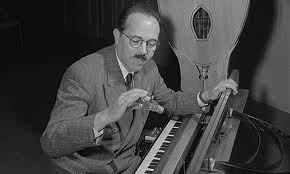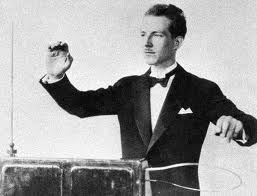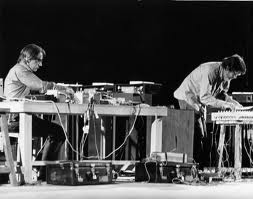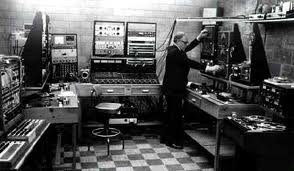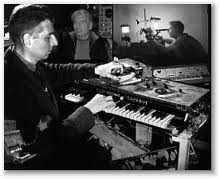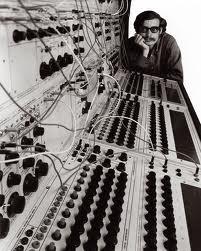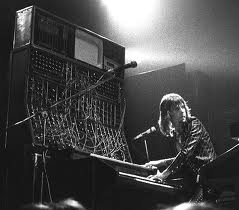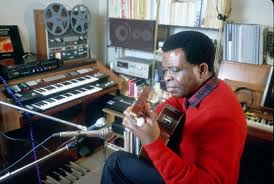Google celebrates the late inventor Robert Moog whose electronic music synthesizer still  holds universes of unexplored and unexploited potential on his 78th birthday by making its Doodle a working, recordable monophonic (one-tone-at-a-time, though three oscillators so it can be a complex tone) mini-Moog. A video demonstration explains how to use it, and good luck with that! Hours of fun!
holds universes of unexplored and unexploited potential on his 78th birthday by making its Doodle a working, recordable monophonic (one-tone-at-a-time, though three oscillators so it can be a complex tone) mini-Moog. A video demonstration explains how to use it, and good luck with that! Hours of fun!
I explored a Moog synth studio at Syracuse University and Roosevelt College (Chicago) circa 1970 – ’75 (also Buchlas and Arps at Mills College in ’72), and enjoyed interviewing Moog in 1995. My assignment was never published, so here it is for the first time, a primer in the history and applications of electronic music instruments.
ROBERT MOOG: I head a company named Big Briar, Incorporated, which I founded in 1978 to design and build electronic musical instruments, especially instruments with alternative controllers–controllers other than keyboards. In the music business these days, that’s what’s called an alternative controller. But there have always been alternate controllers. The first electronic instrument, the theremin, was very alternate and was not at all like a keyboard. So we’re designing alternative conrollers for musicians today. You know, throughout the ’30s and ’40s there was a great deal of experimentation with new sorts of electronic music instruments.
None of these became very popular. The best known are the theremin, the ondes
martenot–which actually has a keyboard, but it has other ways of controlling sound, too–and the Trautonium. But there are many, many different control interfaces, things that musicians put their hands on in order to play the instrument.
HOWARD MANDEL: Was the keyboard really an afterthought, for musicians to have something to work with that was familiar to them?
MOOG: In our work it was an afterthought, but it became one of the central features of synthesizers that people use today in making commercial music.
MANDEL: We’ve heard about Leon Theremin, due to the film about his life that came out this year but who developed the ondes martenot?
MOOG: A man named Maurice Martenot, a French inventor. And the Trautonium was a German instrument invented by Friederich Trautwein. It was in between the theremin and the ondes martenot in its design characteristics.
We’re talking about very different control interfaces here. The theremin you play by moving your hands and face around the instrument. The ondes martenot you play from a keyboard that also has a continuous band along it that you could move your fingers on to change the pitch continuously. Today that sort of thing is called a ribbon controller. The Trautonium is primarily a ribbon controller. That’s where the idea for ribbon controllers came from.
These are all monophonic instruments. The ondes martenot has a six-octave keyboard, but it’s monophonic.
MANDEL: What was the invention, the hardware, that made those instruments possible?
MOOG: The vacuum tube. The theremin was invented just a very few years after the vacuum tube was invented. That’s the dawn of electronics, though after Edison. The vacuum tube was invented by Lee DeForest some time around 1910.
MANDEL: Then Theremin was the first person to be inspired to apply electronics to musical uses?
MOOG: I think there were a few other attempts to make musical sounds with electronics before that, but he was the first one to have the clear vision of a new sort of musical instrument, one that would sound completely different and be played completely differently than anything that had existed before that. See, Theremin as a musician as well as a physicist. I’m not sure about Trautwein, I know less about him than I do about Theremin. I imagine Martenot was also a musician, but I know for a fact that Theremin had a high school level degree in cello. In Russia, that meant something.
MANDEL: It translated on the theremin into the kind of vibrato that a cellist is able to achieve?
MOOG: Yes.
MANDEL: What is it about the vacuum tube that is adaptable to these kinds of uses?
MOOG: The vacuum tube is the basic device of electronics. When you talk about electronic technology, you’re talking about things that you can do first with vacuum tubes and then with transistors and integrated circuits. One thing a vacuum tube allowed you to do was to amplify an electrical signal. Another thing it enabled you to do was to shape wave forms differently. Those two things together enable you to design a wide variety of musical instruments.
MANDEL: So those are the foundation inventions, and everything after is a refinement?
MOOG: Well, they’re further developments. The vacuum tubes that were available in 1920 were just the beginning. By 1930 there were many different kinds of vacuum tubes, and by 1940 there were even more, and by the early ’50s you had transistors.
MANDEL: Which are miniaturized, but do the same thing?
MOOG: They’re a lot smaller than vacuum tubes; they also work in different ways than vacuum tubes. But they still allow you to amplify and to shape wave forms.
MANDEL: Is it fair to say that in none of these cases the primary purpose of the invention was to address musical problems?
MOOG: I don’t know what you mean by musical problems. Leon Theremin had in his mind a very clear idea of making a new musical instrument. It wasn’t a problem for musicians generally that a theremin didn’t exist, but it was a problem for Leon Theremin.
MANDEL: I mean to say, the development of transistors, for instance, was in the unfolding of electronics rather than in the unfolding of musical instruments, initially. I gather people like Theremin, Martenot and Trautwein seized on such inventions and understood how they could apply them to music.
MOOG: Yes, that’s right. What has happened throughout human history is that when an innovative musical instrument builder seeks to do something new he uses the most advanced technology of his time. Two or three or four thousand years ago the most advanced technology was making things out of bamboo segments and goatskins and so on. Those were the first musical instruments. In the 16th and 17th centuries, fine woodworking was a very high craft, the top technology of its time. Everything fine was made very carefully out of wood, and that’s where our violins come from.
In the 19th century manufacturing technology was the latest technology, and that’s where pianos and trumpets and so forth come from. In the 20th century the newest technology is electronics, and if you look through the 20th century for new musical instruments you’ll find almost nothing that’s not made with electronic technology.
MANDEL: Continuing on into digital technology?
MOOG: Digital technology is a subset of electronic technology.
MANDEL: If we focus on where musical and technological developments intersect, it seems the next juncture was musicians working with tape recorders during the ’30s.
MOOG: No. The tape recorder was invented in Germany towards the end of the Second World War. The very first tape recorder in the U.S was brought over from Germany by soldiers returning to this country. It was called the magnetophone–that’s the German word for tape recorder. Or maybe it was a brand name in Germany. Whatever; in Germany they were a top military secret. During the Second World War they weren’t used for recording music at all, but rather for recording Hitler and playing his speeches back at different times from different places in order to confuse the Allies as to where Hitler was. That was the first use of tape recorders.
The magnetophones that were brought to the States at the end of World War II were delivered to a motor company in Redwood City, California called Ampex, and they became the basis of Ampex tape recorders.
MANDEL: Didn’t music concrête precede World War II?
MOOG: It might have, but you could have made music concrête with wire recording and even disk recording. I never heard of anything but the very occasional theremin before the Second World War. Music concrête as far as I know, began around 1947 or ’48, in Paris.
MANDEL: John Cage’s “Imaginary Landscape No. 1” of 1939 is often referred to as the
first electronic composition not employing any instruments. He used three oscillator-generated tones.
MOOG: I’m not sure it’s the first such composition. There was a lot of experimentation before that. In fact, throughout the ’30s there were performances on electronic musical instruments on radio all the time. After all, the Hammond organ was invented in 1935, by Laurens Hammond, who ran the Hammond Clock Company. They made such good clocks that they never wore out and his market dried up, so in the early ’30s he was looking for something to keep his factory busy and he came up with the Hammond organ.
MANDEL: Was that conceived as a theater instrument or a home instrument, do you know?
MOOG: I don’t think he had in mind to limit it. Some models were appropriate for the home, some for churches, some for theaters.
MANDEL: What was the thing he developed that made it possible? And that’s a keyboard-triggered device, isn’t it?
MOOG: The Hammond organ is a series of very, very tiny electro-mechanical generators; the rotating part of these generators are just the size of a coin. The electricity each of them puts out is of a different frequency, which gives you the different notes when you press different keys, yes, on a keyboard. But the charge is so weak that if you fed it through a loudspeaker you couldn’t hear it.
That much was possible even in the 19th century. What made it practical in 1930 was electronic amplification became available and fairly common, so that every Hammond organ could contain an electronic amplifier and speakers. You know, I recently wrote an article on the technical side of the development of electronic music instruments from the very beginning for The Encyclopedia of Applied Physics; it has a lot of this background in it.
MANDEL: Is most of the interest today in electronic music inventions in the area of applied physics studies and research?
MOOG: The interest is more widespread than that, especially among younger musicians.
MANDEL: Electronic music has permeated popular music culture, and also, since the ’50s, gained a foothold in what we might call contemporary classical and academic music circles, as at the Columbia-Princeton Electronic Music Center and similar facilities around the country. Was there some technological development in the ’50s that made those academic institutions feasible?
MOOG: Well, the Columbia-Princeton Electronic Music Center goes back to 1951 or ’52 when Vladimir Ussachevsky gained access to the first tape recorder in the Columbia
University music department. Without tape recorders, it was very hard to compose with electronic sound. You couldn’t store your sounds anywhere.
MANDEL: So electronic music instruments prior to tape recorders were primarily performance instruments?
MOOG: Of course, anything you could perform you could also record. But in addition to performance instruments there were a few electronic instruments with which you could enter a score then play it back automatically. That goes back to 1929, and the Kuplo Givelay [sp?] synthesizer. It ran from a pneumatic piano roll, a paper roll, just like a player piano. And in fact, the RCA Electric Sound Synthesizer that got a lot of press around 1955 used the same sort of control means, a paper roll onto which a code for the various notes were punched.
MANDEL: When did you get involved with electronic music instruments?
MOOG: I started making theremins when I was 19 years old, and I sold them, as a part-time business, from that time until 1964, when I met a musician named Herbert Deutsch who wanted to compose with electronic sound. He’s still active today; he’s at Hofstra University in Hempstead, Long Island. Building a theremin was a popular hobby project in those days–in fact, it still is. It’s a medium-difficult project, not the easiest thing but something most committed electronic hobbyists can do.
MANDEL: Are you a musician?
MOOG: I’m enough of a musician to know the language, but not enough of a musician to entertain people. I like working with musicians: they’re crazy. Nice crazy. Crazier than electronic engineers, who are a pretty predictable bunch.
MANDEL: Did the generation of electronic music come mostly from musicians saying to electronic engineers, “This is what I want to do, can you give me that?”
MOOG: I think that’s the wrong way to look at it. It’s been an ongoing interaction, and it’s impossible to say which way “most” of the interaction went, who generated “most” of the activity. People like me who like working with musicians and like technology, too, are part of the picture, and musicians who want to have new instruments and make new sounds are the other part. Without either part, you don’t have a complete picture.
Also, there’s the cultural background. By the time you get to the 1960s everybody’s a little bit, shall we say loose, and inclined to try new things.
MANDEL: There’s a spirit of invention.
MOOG: Let’s go back to Leon Theremin. He invented his space-controlled instrument at a time when everybody was optimistic that technology was going to be a tremendous benefit to humanity, and he created a tremendous lot of excitement. Up to 1938 he created an incredible variety of new things, all the way from burglar alarms to televisions to new musical instruments.
But in 1929 and 1930 suddenly all this optimism evaporated. People were broke, times were very conservative, and even though Leon Theremin invented all these things it never did him any good. He wasn’t able to sell them. In 1938 he finally went back to Russia [on Stalin’s orders, Theremin was abducted from his home studio in Manhattan by K.G.B. agents] and stayed there right up until 1989.
So you definitely need times when people are a little bit optimistic and interested in trying new things, and that was more true in the late ’50s and early ’60s more than it was say, in the ’30s.
MANDEL: It was true in post-War Europe where there was rebuilding, and in the U.S. where universities expanded to absorb returning G.I.s, too.
MOOG: Right. Now, computers didn’t figure into electronic music production in universities until much later. Columbia-Princeton didn’t have computers until the ’80s. Before that, it was 100 percent analog technology. When I attended Columbia I was in the engineering school, and I didn’t know about the Columbia-Princeton Electronic Music Center. It was in the music department, in another part of campus. I heard about it only through occasional comments by Peter Mauzey, my laboratory instructor, who was the EMC technical director. Vladimir Ussachevsky, the musical director, started off as a musician. He came to this country to get an engineering education, but instead found himself getting a Ph. D. in music. It was fairly common, but not at all universal, for people who got involved in electronic music to have interests in both technology and music: Lejaren Hiller, for example, was a chemist. But I think Ussachevsky considered himself primarily a musician–at one point he thought he might become an engineer, but he never did–and certainly his associate Otto Luening was a musician, a composer, who’d done a lot of composing even before the tape recorder was invented.
MANDEL: Ussachevsky, like Theremin, had come from Russia. Was there international communication about electronic music esthetics and technology? Did the Columbia-Princeton people talk to Karlheinz Stockhausen at Darmstadt in Germany, or Pierre Schaeffer and the music concrête people in Paris?
MOOG: It was slight. At one point, Ussachevsky went to Europe to visit the facilities and learn something, but it wasn’t what I’d call a network. There was no E-mail back then; there was barely air mail. The only way to really find out what was going on was to go and see. Ussachevsky made his trip far into the development of the Columbia-Princeton EMC.
MANDEL: Were different kinds of equipment being developed in Darmstadt and in Paris?
MOOG: Yes. Mauzey developed a lot of stuff himself. Lejaren Hiller at University of Illinois developed a lot of stuff. Both of those people were our customers when we first began. There was Myron Schaeffer [CQ] at the University of Toronto, where they had the
services of Hugh Le Caine an engineer interested in electronic musical instrument design who worked for the National Research Council of Canada. He developed a lot of stuff that had a lot of influence on the rest of us.
MANDEL: Wasn’t there also research done at the Bell Labs?
MOOG: That began somewhat later. Max Matthews was at Bell Labs. He was an amateur musician, and under his guidance there were a lot of musicians-in-residence who worked first with tape recorders and then, later, with computers.
MANDEL: To return to when you founded your first synthesizer company…
MOOG: We were making theremins, and I was still a graduate student, and I met Herbert Deutsch, and we began to collaborate. Just for fun. He was interested in having electronic equipment that made new electronic sounds. What I came up with for him turned out to be the basis for the Moog synthesizer. My idea was to have modular components that would either generate or modify different parts of the musical sound. The way you hook these up together determines what the total sound sounds like. Some of these modules already existed, and some of them didn’t. I started with a voltage-controlled oscillator and a voltage-controlled amplifier. This is all covered in my article.
MANDEL: You discovered there was a market for this synthesizer, interest in it, applications for it?
MOOG: Neither Deutsch nor I saw any commercial potential. One Sunday we drove up to Toronto and showed it to Myron Schaeffer, and he gave us a lot of encouragement. More to the point, he told some other people about our stuff. The next thing we knew we were invited to appear at the 1964 Audio Engineering Society convention in New York City. That was the beginning of our being in business. Until then we never thought of a synthesizer business.
Our first customers were experimental musicians in universities and the occasional private experimental musician, somebody who’d be using new technology to make radio commercials. Our very first customer was Alwin Nikolais, the choreographer.
MANDEL: Were these polyphonic instruments?
MOOG: No.
MANDEL: How big were they? Table-sized, stacked up?
MOOG: Yeah, they were large. They were studio instruments. It took a long time to set them up.
MANDEL: And to set up particular sounds on them?
MOOG: That took a long time, too.
MANDEL: So how did your company proceed?
MOOG: We began filling orders for universities. We built equipment for the Columbia-Princeton center, and for the University of Illinois. At that time we were the only company building equipment for experimental electronic composers. In the first couple to three years, everything was more or less customized.
MANDEL: How specific would musicians be about what they wanted? Would they talk to you in electronic terms?
MOOG: Ussachevsky gave me a piece of paper with technical specifications on it; he was 100 per cent specific. In other cases, they’d wave their hands. It was different with every musician. And every musician imagined the inventions could do something different for them regarding timbre, rhythm and wave-forms. To the electronic musician at that time it was like one big sandbox. The possibilities were almost unlimited.
MANDEL: I suppose the customization you did eventually influenced other manufacturers to strike out, initially imitating your work?
MOOG: The first competition we had was after Switched-On Bachcame out and our synthesizers became commercially important. The commercial world started buying them and using them to make money rather than to do interesting experiments.
MANDEL: Was Donald Buchla, who worked with touch-sensitive synthesizers, one of your competitors?
MOOG: He began around the same time I did, but with a different group of musicians, also experimentally-minded, on the West Coast. Morton Subotnik and that group. There’s no clear line between one person wanting these and there being a market for it. A few people wanted them, and there was enough money from grants and what-not for it to be a viable business for Buchla. That’s how we began, too.
But our business was not viable until Switched-On Bach. That record showed the world that electronic instruments could play classical compositions, and that electronic music could make money, too. Until then the conventional wisdom in the music business was that you couldn’t make real music with a synthesizer. Real music being music that makes real money. At the end of 1968, Switched-On Bach changed all that.
MANDEL: Did you work closely with Walter Carlos, who made that music?
MOOG: Yes. He had a large, modular synthesizer in his little studio where Switched-On Bach was created, in the corner of his living room. He had the synthesizer, an eight-track Ampex tape recorder, and a very simple mixer. Eight-track recording had just been developed around that time, too. So it was sort of an adjunct invention electronic musicians could run with, and professional recording facilities snapped it up, too. But as far as I know, the Columbia-Princeton center never had an eight-track tape recorder. The most tracks on any of their recorders was four.
MANDEL: So Carlos created electronic renditions of Bach pieces by layering sounds to build complexity, and that was a significant development, too?
MOOG: Yes.
MANDEL: Weren’t these instruments beginning to be used in performance situations like in New York’s Electronic Circus around that time?
MOOG: It was very experimental up until, say, 1970, when Keith Emerson used in on the first Emerson, Lake and Palmer record, and then suddenly it was part of their stage
show. Which was barely feasible. It was a grunt. A typical musician today couldn’t have coped with that mess. It was our standard modular synthesizer; we didn’t make the mini-Moog, the first non-modular instrument, until 1971.
MANDEL: Was the mini-Moog a big compromise in terms of what it could do?
MOOG: Yes. It had fewer voices. But it was very accessible.
MANDEL: Were these instruments also being used for light shows at the time?
MOOG: No. That happens today, sometimes in connection with computers; some of it is similar technology, some of it isn’t. You can apply voltage controls to lighting. Today, with MIDI–Musical Instrument Digital Interface–you can control lighting at the same time you control musical sounds. I don’t think there was a single standard like that before the invention of MIDI in 1983.
MANDEL: Where did that come from?
MOOG: It’s been well-documented in a book called A Comprehensive Introduction by Joseph Rothstein.
MANDEL: MIDI has transformed everything, hasn’t it? It’s the common interface that everybody uses.
MOOG: Yes. We’re just one of many, many companies that supply hardware that works with MIDI. And we work today with both analog and digital equipment. These days digital electronics is used primarily for control and storage; analog technology, if it’s used at all, is used for generating and modifying sounds. Most musicians think that analog-produced sounds sound better than digital sounds.
Everything has to do with the waveform. The waveform is the sound, so any quality of the sound has to do with the waveform. It has to do with very, very fine details of the sound, things that are almost impossible to measure with electronic instruments but that you can hear–musicians can hear–distinctly.
MANDEL: Not only hear, but isolate and address or modify?
MOOG: Yes. The difference between analog and digital sound is like the difference between film and video.
MANDEL: Did your business significantly expand with your introduction of the mini-Moog?
MOOG: Oh, yes. After 1971 if you were a working keyboard player at the local Ramada Inn you had to have a synthesizer; otherwise, you couldn’t get a job. It’s like today if you want to be a secretary you have to know how to use a computer. That’s how it was for musicians in 1971.
MANDEL: Was there resistance to that?
MOOG: The only resistance was that it cost a lot of money to buy that stuff. It was outrageously expensive back then. It’s much cheaper today to get enough hardware together to be a musician.
MANDEL: But every Ramada Inn keyboard player scraped it up somehow.
MOOG: Yes. That’s how the Japanese got into this. They geared up to make inexpensive synthesizers that worked well.
MANDEL: Were they using the principles that you developed?
MOOG: In the beginning, yes. As time went on, less and less. Up until about 1982 the differences between our synthesizers were fine technical details. The Japanese manufacturers just found ways of getting 80 per cent of the sound for 50 per cent of the money. That’s more of a marketing and technical thing than a musical thing. But starting in 1982, Yamaha introduced an all-digital synthesizer. The sound was made digitally, as well as controlled and stored digitally. That was the Yamaha DX7 synthesizer. It was a lot different than the technology that we used in the ’60s and ’70s.
MANDEL: Up until then, a lot of your work was to economize and to miniaturize?
MOOG: Yes, and to get new sounds. Everybody was always looking for the latest thing.
MANDEL: To imitate better or more acoustic instruments?
MOOG: To create the sound of the times. The early synthesizers didn’t imitate anything, they had their own sounds. A lot of today’s instruments are designed specifically to imitate orchestral and acoustic sounds, but the instruments of the 1970s, none of them did that.
MANDEL:Â Does that date their sounds?
MOOG: Oh, yes, yes. Any musician who is at all knowledgeable about electronic instruments can listen and tell you which model of which manufacturer and what year it was made. A layman may not be able to do that, but a layman can say, “Boy, that’s a ’60s sound” or “That’s a ’70s sound.”
MANDEL:Â So the ’80s sound was the introduction of the Yamaha DX7.
MOOG: Yes, with what’s called FM, for “frequency modulation.”
MANDEL: How does that work?
MOOG: It’s a mathematical algorithm that was used to generate the waveforms digitally that came out of the DX7 synthesizer.
MANDEL: Did that put a crimp in your business for a while, sir?
MOOG: Well, I’d been long out of that business by then. I left Moog Music in ’78, when I formed Big Briar. Whereas Moog Music was in the mainstream of new electronic music instruments, Big Briar positioned itself at the very edge, which is where I began in 1964. And that’s pretty much where we still are.
I’m not inclined to run or be part of a big business here. If we’re going to be a small business, then we have to do something that’s at the edge rather than competing with large manufacturers who are in the mainstream. What we’re interested in doing now is not all that interesting from the point of view of future developments. We’re building theremins because I’m an experienced theremin builder at this point, and there is a market for theremins right now, albeit a very small market.
MANDEL: Is the theremin you build a performance instrument or a studio instrument?
MOOG: It’s a performance instrument. But you can use it in a studio, like using a guitar in a studio. The guitar’s a performance instrument, too. The theremins are performance instruments, but we’re working on equipping them with MIDI, which will make them compatible with all modern hardware and software.
MANDEL: Do well-known bands or performers use theremins onstage today?
MOOG: Among our clientele, Laurie Anderson is fairly well-known. Quite a few groups
use theremins occasionally. It’s still specialty instrument for most people.
MANDEL: So the theremin and the MIDI interface and other alternate triggering devices employing the same kind of principles–hand controlling–this is some of what you’re researching?
MOOG: All control devices work by hand control. The theremin is the only one that works with motion of the hands and space around the instrument, without touch. Other devices we’ve experimented with require touch but, of course, you use your hands. Because the control interface of the theremin was designed almost 75 years ago, while it’s interesting to us, it’s not new. We have ideas for a lot of different control interfaces which are new, but we’re not working on those in terms of introducing new products right now. We have six people here, it’s a very small business, and we’re not trying to constantly do everything new.
MANDEL: Was there a single invention that allowed polyphony to be available?
MOOG: No, it was a slow development of technology. First there were transistors, then there were simple integrated circuits, and more complex integrated circuits, and as the prices went down–it’s all a function of price. We actually built a few experimental polyphonic instruments, which were very expensive, in the ’60s. One we built was a whole rack of circuit boards. You could have its same capability today on a desktop computer.
MANDEL: Is sampling an outgrowth of the digital storing of sonic information?
MOOG: It is digital storing of sonic information. An outgrowth? Well, the instruments that came out in the late ’70s were not sampling at all. They were analog instruments with digital storage of the settings of the front panel. The settings of the front panel are not the sounds, you know–they are the numbers that determine what the sounds are. It takes a very small amount of digital memory to remember the settings of, say, two dozen front panel controls. It takes a great deal of memory to remember a complete sound, let alone a whole bunch of sounds. So the very first sampling instruments cost thousands of dollars–$50,000, $60,000. These were sampling instruments when computer memory was still expensive, and as time has gone on they’ve become cheaper and cheaper because computer memory has become cheaper and cheaper. Now you can go to your local mall and buy a Soundblaster soundcard with every sound in creation on it–one megabyte of sound–and the whole card costs $250.
MANDEL: Is that an invention that’s different in kind?
MOOG: Storing sounds digitally is considered to be a different technology than storing the settings of panel controls for making analog sounds. They are technologically different.
MANDEL: But in terms of the musical result–
MOOG: Sampling gives you big sounds that are interesting, but they get boring fast. You can’t change them, you can’t mold them. But a synthesizer, something that generates or calculates the waveform as you need it, is something that’s much more malleable, much more subject to experimentation.
MANDEL: Have you found that musicians who are interested in being on the edge of this area of music have become more technologically knowledgeable?
MOOG: Yes. I don’t think any musicians today would seriously consider making it a career without knowing enough about electronics to understand very well how such music is generated and recorded. But I don’t think you should look for evidence that a lot of these guys start off as technicians. A few of them did, but most of them picked up what they needed because that’s what would enable them to do what they wanted to do.
MANDEL: Did they then invent something other people built on in the technological, as opposed to the esthetic, side?
MOOG: Yes.
MANDEL: So if I talked to Richard Teitlebaum about this, I’m headed in the right direction?
MOOG: Yes.
MANDEL: David Behrman?
MOOG: Sure.
MANDEL: George Lewis?
MOOG: Sure.
MANDEL: David Rosenboom?
MOOG: Sure. Oh, yes.
MANDEL: Todd Machover?
MOOG: Yeah. There’s a guy who probably has some technical background because he’s at MIT
MANDEL: Neil Rolnick? Carl Stone?
MOOG: Sure, yes, sure. But these are all old names by now. There are a lot of people out there now, and a lot has happened in the last 75 years. There are festivals–for instance, next week some of Neil Rolnick’s students [from Rensellaer Polytechnic Institute in Troy, New York] are going to be at Bard College, where Richard Teitlebaum’s teaching, to give performances–and there’s bound to be some networking there. There are more than enough electronic musicians now to sustain a very active network.
MANDEL: Do you think eventually some of their sort of arcane esthetic developments will seep into the mainstream?
MOOG: Yes.
MANDEL: There was such an explosion of new sounds in the ’60s in rock ‘n roll and jazz and all forms of music…
MOOG: Yes. And there’s very little development of that kind of new sound today. Most musicians, something more than 50 per cent of musicians, are interested in using what would be called “canned sounds,” sounds that somebody else has developed or recorded, put in a machine, and then you just play them. The first time synthesizers with canned sounds were available was in 1978, 1979, when digital technology was used to store the settings for analog sounds, but the sound-producing circuitry was analog.
MANDEL: Did you find that development disappointing?
MOOG: It’s not that I was disappointed–who am I to be disappointed? That’s wha9t the musicians wanted. But not all musicians. There’s a minority of musicians who are interested in doing something new, exploring resources that nobody else has explored.
MANDEL: Are those the people that you feel an affinity with?
MOOG: Yes.
MANDEL: So you think they’ll last?
MOOG: What?
MANDEL: Synthesizers!
MOOG: Well, yes. You remind me of my ex-mother-in-law. I was born and brought up very near LaGuardia Airport, and I took her in the 1980s to LaGuardia. It was the first time she’d ever been there. She looked around and said, “I guess airplanes are here to stay.” My point is that there are millions and millions of synthesizers out there. They’re
not going to go away. Things don’t go away. Harpsichords don’t go away. African drums don’t go away. What musicians use just keeps expanding, more and more.

